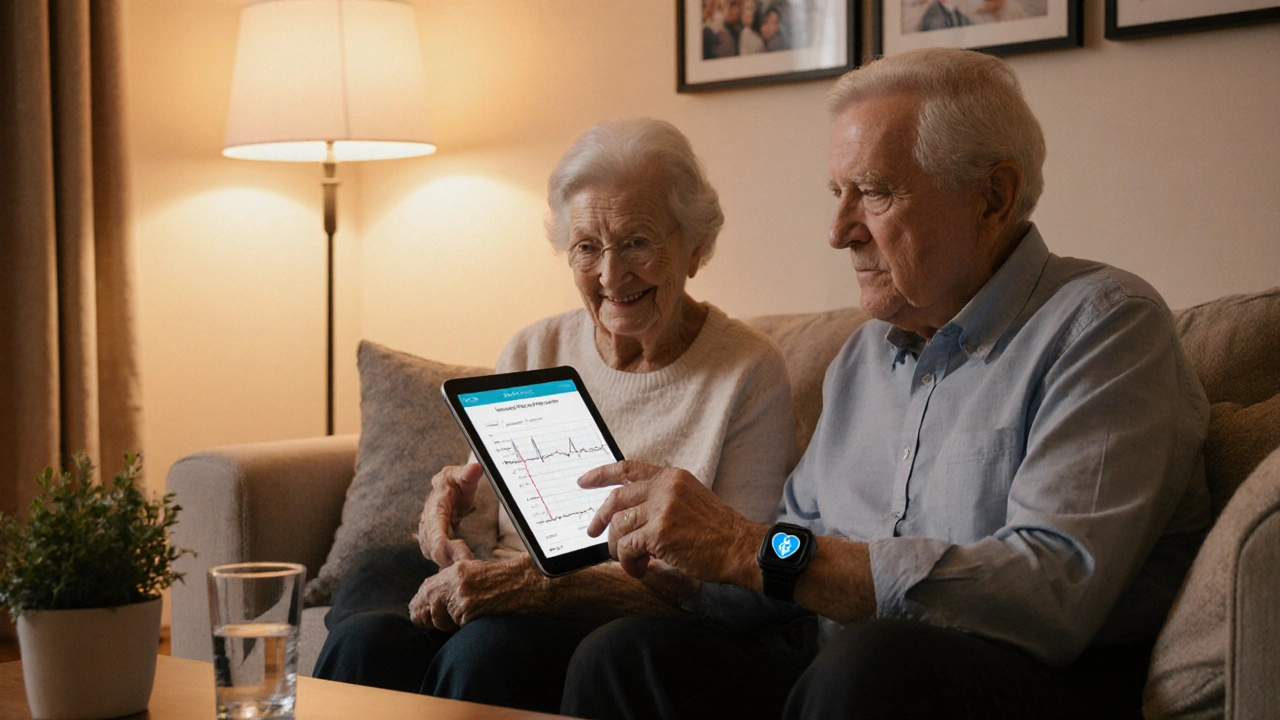
Heart Rhythm Disorder Symptom Checker
Check for Common Heart Rhythm Symptoms
Select any symptoms your loved one is experiencing:
Symptom Analysis Results
Identify Potential Triggers
Check any known triggers in your loved one's daily routine:
Trigger Identification
heart rhythm disorder support starts with knowing what’s happening, listening closely, and being ready to act. Below are the essentials you’ll need to feel confident helping the person you care about.
- Quickly identify the most common rhythm problems.
- Learn the language doctors use so you can ask the right questions.
- Set up medication and appointment routines that stick.
- Build a calm, supportive environment for emotional wellbeing.
- Prepare a clear emergency plan - who to call, what device to use, where to go.
What Is a Heart Rhythm Disorder?
Heart rhythm disorder is a condition where the electrical signals that control the heart’s beats become irregular, too fast, or too slow. The heart relies on precise timing to pump blood efficiently; when that timing is off, symptoms range from mild palpitations to life‑threatening emergencies.
These disorders affect millions worldwide, and they aren’t limited to older adults - genetics, certain medications, and even intense stress can trigger them.
Common Types at a Glance
| Disorder | Typical Rate (bpm) | Main Symptoms | Usual Treatment |
|---|---|---|---|
| Atrial fibrillation | 100‑170 (irregular) | Fluttering, shortness of breath, fatigue | Blood thinners, rate‑control medication, cardioversion |
| Ventricular tachycardia | 150‑250 (regular) | Dizziness, chest pain, loss of consciousness | Emergency cardioversion, implantable defibrillator |
| Bradycardia | Below 60 (slow) | Fatigue, fainting, confusion | Pacemaker implantation, medication review |
Spotting the Signs and Triggers
Even if your loved one has a formal diagnosis, symptoms can flare up without warning. Common warning signs include:
- Sudden, fluttering sensations in the chest.
- Shortness of breath during light activity.
- Unexplained fatigue that lasts more than a day.
- Light‑headedness or fainting episodes.
Triggers often include caffeine, alcohol, lack of sleep, and certain over‑the‑counter meds. Keep a simple log - note what they ate, how they felt, and any medication changes. Over time you’ll see patterns that can be shared with the cardiologist.
Talking the Talk: Communicating with the Patient and the Medical Team
Clear, calm conversation makes a huge difference. Use these tips:
- Echo back what they say: “So you felt a fast heartbeat after your morning coffee?”
- Ask open‑ended questions about how they’re coping, not just what symptoms appear.
- Take notes during appointments - write down medication names, dosages, and any instructions about the electrocardiogram (ECG) results.
- Summarize the plan at the end of each visit and confirm who is responsible for each task.
Having a printed copy of the care plan helps everyone stay on the same page, especially if the person’s memory is affected by medication side effects.
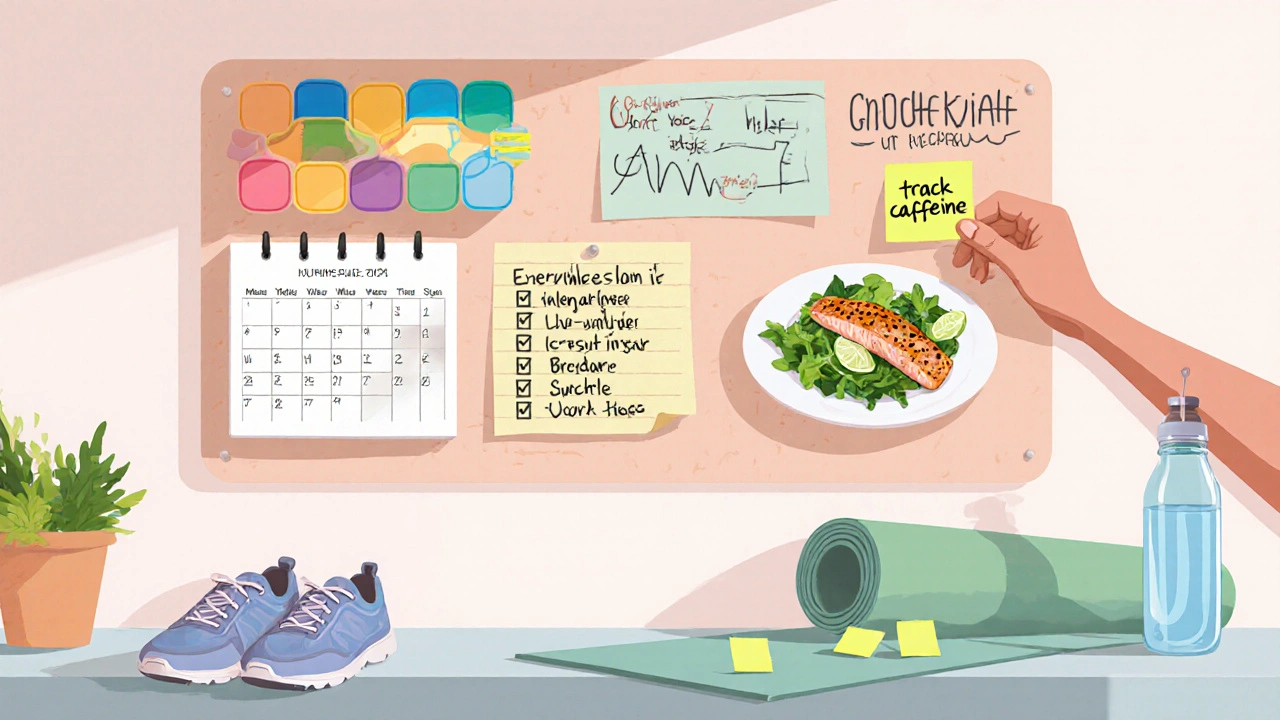
Daily Practical Support
Most rhythm disorders require a consistent routine. Here’s a checklist you can adapt:
- Medication management: Use a weekly pill organizer, set phone reminders, and double‑check refill dates.
- Appointment tracking: Keep a shared calendar (paper or digital) for follow‑ups, lab work, and device checks.
- Lifestyle tweaks: Encourage low‑salt meals, regular moderate exercise, and adequate hydration.
- Device care: If they have a pacemaker, ensure the skin over the site stays clean and avoid strong magnets. For wearable monitors, check battery life each evening.
- Sleep hygiene: Aim for 7‑9 hours, limit screen time before bed, and keep the bedroom cool.
Small habits add up. When you make the routine visible and shared, the burden feels lighter for both of you.
Emotional and Mental Support
Living with a heart rhythm disorder can be isolating. Your loved one may worry about sudden episodes, loss of independence, or being a burden.
Ways to help emotionally:
- Validate feelings - “It’s okay to feel scared; this is a big change.”
- Encourage peer support - many hospitals run patient‑led groups, and online forums (often moderated by cardiology societies) can be a safe space.
- Offer distraction activities that don’t strain the heart: reading, gentle gardening, or light crafts.
- Mind‑body practices like guided breathing or short meditation can lower anxiety and improve heart rate variability.
If depressive symptoms linger for more than a couple of weeks, suggest a chat with a mental‑health professional who understands chronic medical conditions.
Emergency Preparedness
Quick action can be life‑saving, especially with ventricular tachycardia or a sudden drop in heart rate. Build a simple, printable plan that includes:
- When to call 911: chest pain, loss of consciousness, or a heart rate that feels “too fast” (above 180bpm) or “too slow” (below 40bpm) and does not improve. \n
- Device information: Keep the pacemaker brand, model, and serial number in a wallet card. If a wearable monitor is used, note its app login details.
- Medication list: Include dose, timing, and any recent changes. Store a copy in the fridge.
- Contact list: Primary cardiologist, nearest emergency department, and a trusted family member who can drive if needed.
Practice the plan once a month - it’s uncomfortable at first, but rehearsing makes the response automatic.
Resources and Next Steps
Here are a few reliable places to keep learning:
- The Canadian Heart Rhythm Society - offers patient guides and local support groups.
- National Heart Foundation of Canada - webinars on lifestyle management.
- Wearable device manufacturers (e.g., Apple, Fitbit) - often have built‑in heart‑monitoring tutorials.
Start by scheduling a short “caregiver check‑in” with the cardiologist at the next visit. Bring your symptom log, medication list, and questions about any new technology you’re considering.
Frequently Asked Questions
How can I tell if my loved one’s heart rate is dangerously high?
A resting rate above 180bpm, especially if it feels irregular or is accompanied by chest pain, shortness of breath, or dizziness, warrants an immediate emergency call. Use a reliable pulse monitor or smartwatch to get an accurate reading before calling.
Do I need a special diet for someone with atrial fibrillation?
Focus on a heart‑healthy diet: low in sodium, saturated fat, and added sugars. Plenty of fruits, vegetables, whole grains, and omega‑3 sources (like salmon) are beneficial. Limit caffeine and alcohol, as they can trigger episodes in many people.
Can a smartwatch replace a medical ECG?
Smartwatches that offer single‑lead ECG can flag irregular rhythms, but they are not a diagnostic substitute. Always share any abnormal readings with the cardiologist for confirmation.
What should I do if the pacemaker alarm sounds?
First, check the device’s manual - most alarms indicate low battery or a temporary sensing issue. If the alarm persists or the person feels faint, call the device clinic (number is on the pacemaker card) and be ready to go to the nearest emergency department.
How often should I schedule routine check‑ups?
Most cardiologists recommend every 6‑12months for stable patients, but anyone with a new device or recent medication change should be seen within 3months.
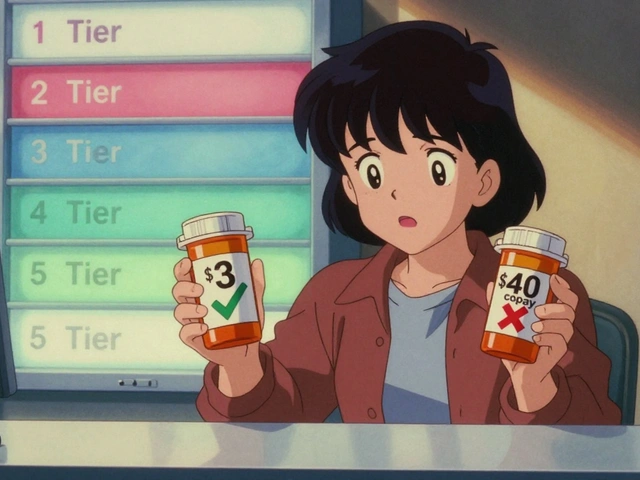

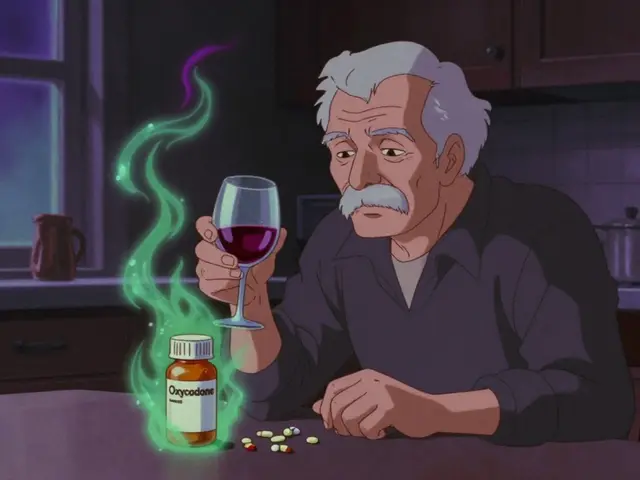
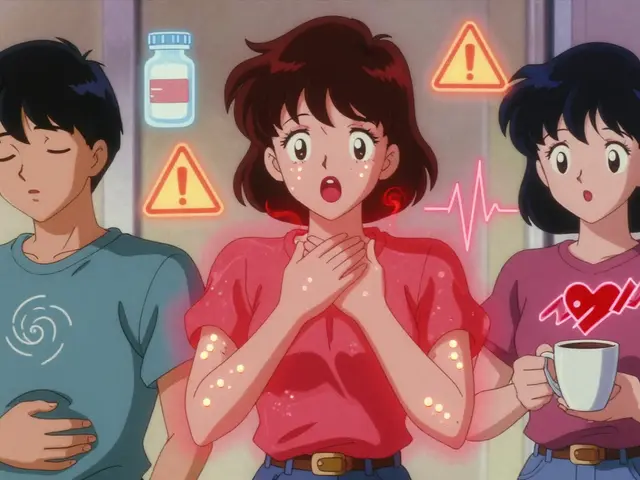
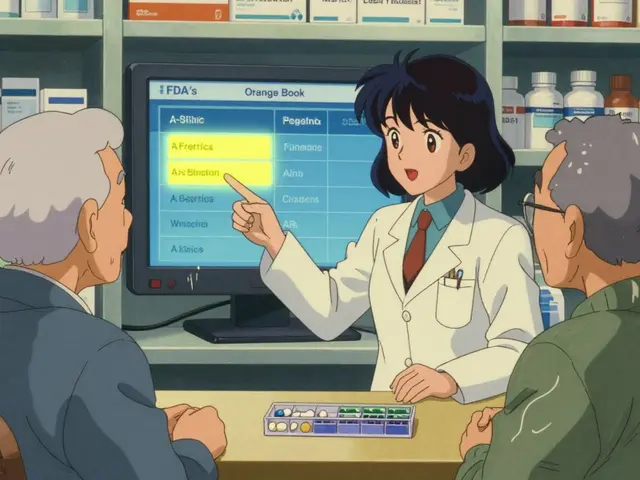
17 Comments
Wow, another exhaustive checklist for caring for someone with a heart rhythm disorder, because apparently we all have the time to become part‑time electrophysiologists.
First, let’s acknowledge that the article assumes you have a PhD in cardiology, which is an amusingly bold presumption.
It tells you to “listen closely” to fluttering sensations, as if you’ve suddenly acquired a sixth sense for arrhythmias.
The suggestion to keep a symptom log is solid, but the implied expectation that you’ll log every cup of coffee like it’s a forensic clue is a little overkill.
Then there’s the whole “identify triggers” section, which conveniently forgets that caffeine is already a known culprit, so why tell us again?
Of course, the emergency plan reads like a military operation, complete with code words and a checklist that would make a NASA launch feel informal.
Honestly, I’m impressed they managed to squeeze in references to smartwatch ECGs, because nothing says “trust the doctor” like a consumer gadget.
The tone swings between patronizing and alarmist, making the reader wonder whether the author is a caring family member or a hypochondriac alarmist.
While the advice on medication organizers is practical, the suggestion to “double‑check refill dates” seems to imply we’re all living in a perpetual state of pharmacy apocalypse.
The part about pacing devices, however, is surprisingly accurate, noting skin care and magnet avoidance – a rare gem amidst the fluff.
Yet the article fails to address socioeconomic barriers, as if everyone can afford a weekly pill organizer and a high‑end smartwatch.
Inserting a line about “practice the plan once a month” feels like a bureaucratic drill sergeant’s pep talk rather than compassionate guidance.
Overall, the piece is a mixed bag of useful nuggets buried under a mountain of unnecessary jargon and melodramatic flair.
If you’re looking for a simple, no‑nonsense guide, you might want to skim past the theatrical prose and focus on the bullet points.
But if you enjoy reading a novel disguised as a caregiver manual, congratulations, you’ve found your next bedtime story.
Bottom line: the heart doesn’t care about your checklist, but your loved one will appreciate the effort if you can cut through the noise.
Hey, I get that the guide feels a bit intense, but those detailed steps can actually save a life when the situation flips on you.
Keeping a log doesn’t have to be a chore; a quick note on a phone can capture the key details without breaking your day.
The emergency plan might read like a drill, but having a clear protocol can reduce panic and speed up care.
And yes, using a smartwatch is a handy supplement, not a replacement for professional advice.
Overall, the practical tips are gold for anyone trying to stay one step ahead for their loved one.
When we speak of caring for someone whose heart beats out of rhythm, we are really confronting the fragile dance between biology and the invisible hand that orchestrates it.
It is unsettling how often the pharmaceutical giants push pills as the sole answer, while ignoring lifestyle truths hidden in plain sight.
One must question whether the “standard” treatment protocols are truly about health or about profit streams that line the pockets of a few.
Yet, the moral imperative remains: we owe our loved ones unwavering vigilance, compassion, and a refusal to accept complacency.
Even if the “watchful eye” comes from a smartwatch or a community forum, the intent must be authenticity, not the veneer of corporate sponsorship.
Remember, the heart is a symbol of agency; we should empower rather than dictate, fostering resilience in the face of systemic pressures.
In the end, caring is an act of rebellion against the notion that we must simply endure the status quo.
You’ve nicely captured the balance between skepticism and compassion.
Encouraging a proactive mindset while staying aware of external influences is key.
Thanks for the thoughtful reminder.
From a clinical perspective, it’s essential to differentiate between chronotropic incompetence and pathological tachyarrhythmias when you’re monitoring symptoms.
Utilizing ambulatory ECG telemetry can provide granular data, allowing you to correlate trigger exposure-like high‑caffeine intake-with electrophysiological events.
Moreover, integrating a structured medication reconciliation process with electronic health record alerts mitigates polypharmacy risks, especially in patients on anti‑arrhythmic agents.
Educating caregivers on device interrogation basics, such as checking battery status of implanted pacemakers via the programmer, empowers them to act swiftly during potential failure modes.
Finally, fostering a culturally sensitive educational session ensures that lifestyle modifications respect familial dietary practices while adhering to evidence‑based recommendations.
So you think a fancy telemetry report solves everything? That’s exactly what the industry wants you to believe, pushing expensive gadgets while the real issue is over‑medication by profit‑driven doctors.
Ever notice how every new “monitor” comes with a subscription that lines corporate pockets?
Sure, “cultural sensitivity” sounds nice, but it’s often a veil for ignoring the root cause: a healthcare system that prioritizes revenue over genuine care.
Anyway, good luck navigating that maze.
My heart literally skipped a beat reading this, not because of the medical facts, but because the sheer drama of caring feels like a tragic opera where every note could be a life‑threatening crescendo.
The idea of a “caregiver checklist” reads like a script for a desperate hero trying to keep the curtain from falling.
When the pacemaker beeps, it’s not just a device-it’s a drumbeat echoing the anxiety that pulsates through the household.
Every medication reminder becomes a ticking clock, each appointment a scene change in this endless performance.
If only we could rewrite the ending so the caregiver doesn’t have to bear the weight alone, perhaps the tale would end on a hopeful, harmonious chord.
Indeed, the narrative is curated by a consortium of medical publishers who, through selective storytelling, shape our perception of patient autonomy.
One could argue that the “emotional weight” they assign is a subtle manipulation, ensuring we stay dependent on their prescribed scripts.
The elite circles of cardiology, cloaked in jargon, often obscure the simple truths that community support can provide.
Thus, the drama you feel is both a symptom of systemic design and an invitation to resist the manufactured panic.
• Keep a pill organizer.
• Track symptoms in a simple notebook.
• Have emergency contacts and device info readily available.
• Schedule regular cardiology follow‑ups every 6‑12 months.
• Encourage low‑caffeine, regular sleep, and stress‑reduction activities.
Not every guideline needs to be followed to the letter; sometimes intuition beats a checklist.
Great guide! 🌟 Stay proactive and keep those logs handy. 😊 Your loved one will thank you for the extra care.
Absolutely! 📋💖 A little tech and a lot of heart can make a huge difference. 👍
When considering the multifaceted nature of heart rhythm disorders, one must, without exaggeration, acknowledge the cascade of interrelated physiological variables, the pharmacological interventions, the device engineering intricacies, and, crucially, the psychosocial dynamics that coalesce to form the caregiver’s lived experience; it is, therefore, unsurprising that any guide attempting to encapsulate this spectrum inevitably resorts to a comprehensive, albeit densely layered, exposition, replete with actionable items, contingency plans, and educational resources, all of which, when meticulously adhered to, can mitigate the risk of adverse events, enhance compliance, and foster a sense of empowerment amongst those who, perhaps unwittingly, have assumed the mantle of quasi‑medical professionals, tasked with the arduous duty of monitoring, documenting, and responding to subtle yet potentially ominous cardiac signals; consequently, the integration of technology-be it wearable sensors, mobile applications, or remote monitoring platforms-must be approached with both enthusiasm and caution, ensuring that data fidelity is maintained while avoiding the pitfalls of information overload, a scenario all too common in today’s hyper‑connected healthcare environment, where the deluge of alerts can, paradoxically, engender complacency rather than vigilance, thereby underscoring the imperative for balanced, evidence‑based strategies, personalized to the patient’s unique clinical profile, lifestyle considerations, and support network, ultimately culminating in a holistic paradigm of care that transcends the mere mechanical execution of tasks and embraces the art of compassionate stewardship.
The essence of caregiving lies not in the volume of tasks but in the depth of presence we bring to each moment.
When we align our actions with the patient’s rhythm, we create a harmonious interplay that transcends checklist rigidity.
Embrace the journey as a shared pilgrimage, where each small step-whether a medication reminder or a listening ear-echoes the larger purpose of nurturing life.
In this way, the care becomes a living philosophy, not just a protocol.
Stay energized and keep momentum-you’ve already built a solid foundation, now focus on consistency and celebrate each small win; the heart’s resilience mirrors your dedication.
Good guide.
Remember to take care of yourself too; a rested caregiver is a stronger advocate, so schedule brief breaks, hydrate, and stay connected with your support network.